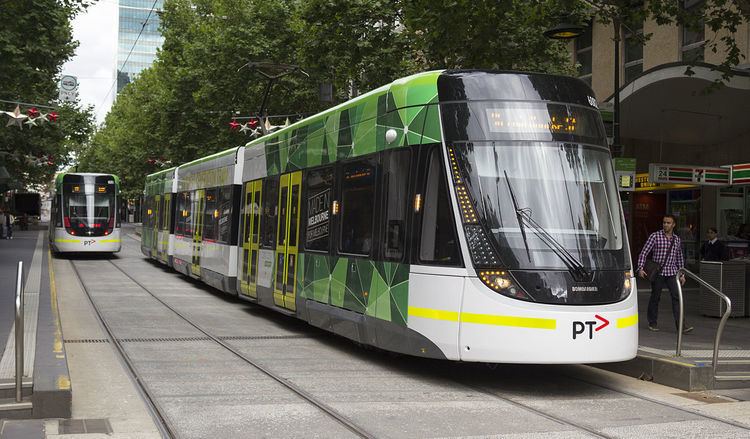Assembly Dandenong Fleet numbers 6001–6070 | Constructed 2013–present | |
 | ||
Number in service 47 with 1 under testing and commissioning (February 2017) Capacity 64 (Seated)146 (Standing) | ||
The E-class trams are three-section, four-bogie articulated trams that were first introduced to the Melbourne tram network in 2013. They are being built by Bombardier Transportation's Dandenong factory, with the propulsion systems and bogies coming from Bombardier factories in Germany.
Contents
The E-class is part of the Tram Procurement Program, a Public Transport Victoria project aimed at increasing capacity and reliability of the tram network through the introduction of new trams, creation of new depot space, and upgrades to existing infrastructure. In September 2010, 50 were ordered with an option to purchase a further 100. In May 2015, a further 20 were ordered which will take the total to 70.
The first tram was delivered in June 2013 and after testing entered service on route 96 on 4 November 2013. As of 9 February 2017, forty-seven were in service with 1 undergoing testing and commissioning.
History
In July 2009 the Victorian Government called for expressions of interest for the construction of 50 new trams. The expression of interest stipulated that the trams be low floor to comply with the Disability Discrimination Act, that 40% of the total contract was to be local content and that the first were to enter service in 2012.
In October 2009 Alstom and Bombardier were shortlisted to bid for the contract. The invitation to tender stated the contract had been declared a strategic project, requiring a minimum 25% local manufacturing content, and 50% local content over the life of the contract, with 150 jobs expected to be created.
Bombardier were awarded a $303 million contract for 50 Flexity Swift low-floor trams, with maintenance to 2017 on 29 September 2010; the contract includes an option for a further 100 vehicles. They are being built at Bombardier's Dandenong factory with local design input, including aesthetic design by Bombardiers Brisbane-based Industrial Design team, with propulsion systems and bogies coming from Bombardier’s German factories in Mannheim and Siegen respectively. They are the first trams built in Australia in 12 years, and the first locally built Melbourne trams since the last B-class was delivered in 1994.
The trams are 33 metres (108 ft) long, 2.65 metres (8 ft 8 in) wide with three articulated units and four bogies, they are low-floor with anti-slip flooring, air-conditioned, have automatic audio-visual announcements, and a passenger capacity of 210. A two-thirds mock up was produced for design input and unveiled on 24 August 2011; it was displayed at the 2011 Royal Melbourne Show. A seven-month delay in delivery was announced in August 2012, with Bombardier stating that design complexity had slowed down construction, and the E-class would be operating from July 2013, and the last delivered in 2018.
The first E-class tram arrived at Yarra Trams' Preston Workshops on 28 June 2013 to begin final testing, and was publicly unveiled on 1 July 2013. Testing started in mid-July 2013, and by September 2013 there were two E-class trams at Preston Workshops undergoing non-passenger testing in preparation for introduction to service in late 2013. Two E-class trams entered service on route 96 on 4 November 2013 after an unveiling at Southbank Depot, with a further three in service by January 2014.
Other models of Bombardier's Flexity Swift tram of comparable length have four motors with each providing between 120 and 150 kW, however the E class has 6 x 85 kW motors powering three bogies with one bogie unpowered. In July 2014, it was revealed that Yarra Trams would have to build more substations to cope with the large amount of power that the trams require.
In May 2015, the State Government announced it had ordered a further 20. The next route to be operated by E-class trams will be route 86 from November 2016.
According to Time Out (magazine) Melbourne, the E-Class are rated as the favourite tram amongst the city's tram passengers due to their size, design and comfort.
In service
E-class trams now operate on routes 11, 86 and 96, but have been used for special events such as the 2015 AFC Asian Cup, the Australian Open and White Night.
Associated works
A package of works – the Tram Procurement Program – is being delivered by Public Transport Victoria to increase the capacity and reliability of Melbourne's tram network. This includes: the order of 50 trams; upgrades to route 96; upgrading the power system; improving accessibility on other low-floor routes; and the redevelopment of Preston Workshops and upgrades to Southbank depot to store and maintain E-class trams. Over $807.6 million has been allocated to this project by the Victorian Government.
In anticipation of the E-class trams, a $24 million upgrade Southbank Depot was completed and included upgraded the maintenance and office facilities. Route 96 is being upgraded for the E-class trams, accessible stops will be constructed, along with further segregation of trams from cars, and increased priority at intersections.
